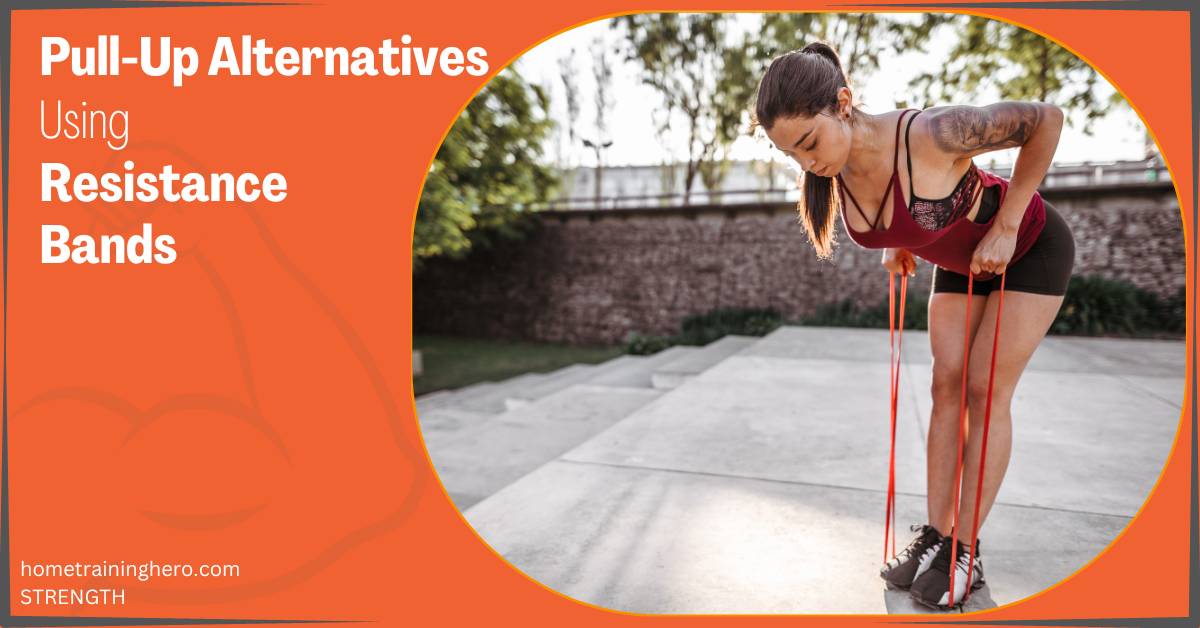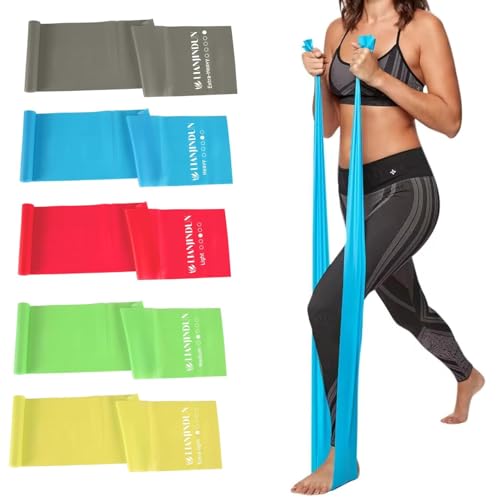In the world of fitness, versatility is key. And when it comes to building upper body strength and targeting those back muscles, pull-ups are a go-to exercise.
But what if you don’t have access to a pull-up bar or struggle with traditional pull-ups? That’s where resistance bands come to the rescue!
In this comprehensive guide, we’ll explore pull-up alternatives using resistance bands – ensuring you get a killer workout without the need for a gym or special equipment.
Contents
- 1 Why Pull-Up Alternatives Matter
- 2 The Benefits of Resistance Bands
- 3 Pull-Up Alternative #1: Assisted Pull-Ups
- 4 Pull-Up Alternative #2: Lat Pulldowns
- 5 Pull-Up Alternative #3: Face Pulls
- 6 Pull-Up Alternative #4: Bent-Over Rows
- 7 Pull-Up Alternative #5: Renegade Rows
- 8 Setting Up Your Resistance Band Pull-Up Alternatives Workout Routine
- 9 Sample Resistance Band Pull-Up Alternatives Workout Routine
- 10 Monitoring Your Progress
- 11 Final Words
- 12 Other Helpful Resources
Why Pull-Up Alternatives Matter
Pull-ups are a fantastic compound exercise, engaging multiple muscle groups, including your back, biceps, and shoulders. They’re a staple in many workout routines because of their effectiveness in building upper body strength. However, not everyone can perform traditional pull-ups due to factors like lack of equipment or physical limitations. This is where pull-up alternatives with resistance bands become invaluable.
The Benefits of Resistance Bands
Before we dive into specific pull-up alternatives, let’s understand why resistance bands are an excellent choice:
1. Portability and Accessibility
Resistance bands are lightweight, compact, and portable. You can easily carry them anywhere, making it convenient for home workouts, travel, or outdoor training sessions.
2. Variable Resistance
One of the key advantages of resistance bands is their adjustable resistance levels. Whether you’re a beginner or an advanced athlete, you can choose the appropriate band to match your strength and fitness goals.
3. Joint-Friendly
Unlike some exercises that put strain on your joints, resistance bands provide a smooth and controlled range of motion, reducing the risk of injury.
4. Versatility
Resistance bands can be used for a wide range of exercises, making them a versatile addition to your fitness routine. From strength training to stretching, they’ve got you covered.
Pull-Up Alternative #1: Assisted Pull-Ups
Assisted pull-ups using resistance bands mimic the motion of a traditional pull-up while providing support. Here’s how to do it:
- Attach one end of the resistance band to a sturdy anchor point, like a pull-up bar.
- Loop the other end around your knee or foot, depending on the band’s length and your desired resistance.
- Grip the bar with your hands shoulder-width apart.
- Perform pull-ups as you would normally, with the resistance band assisting your ascent.
This exercise effectively targets your back and biceps while allowing you to gradually build the strength needed for unassisted pull-ups.
Pull-Up Alternative #2: Lat Pulldowns
Lat pulldowns are a fantastic alternative to target your latissimus dorsi muscles, which are the primary muscles engaged during pull-ups.
- Secure the resistance band overhead, ensuring it’s attached to a sturdy anchor.
- Sit or kneel in front of the anchor, facing away from it.
- Hold the band with a wide grip, palms facing forward.
- Pull the band down towards your chest, engaging your lats and keeping your elbows pointed downward.
- Slowly release the band to the starting position.
Repeat this movement to strengthen your back and improve your pull-up performance.
Pull-Up Alternative #3: Face Pulls
Face pulls are an excellent exercise for targeting the muscles in your upper back and shoulders, helping to improve your posture and overall upper body strength.
- Attach the resistance band to a secure anchor point at chest height.
- Stand facing the anchor and grip the band with both hands, palms facing down.
- Pull the band towards your face, keeping your elbows high and wide.
- Squeeze your shoulder blades together at the end of the movement.
- Slowly return to the starting position.
Face pulls are not only a great pull-up alternative but also a crucial exercise for maintaining shoulder health.
Pull-Up Alternative #4: Bent-Over Rows
Bent-over rows are effective for building back muscle strength and can be easily adapted with resistance bands.
- Step on the middle of the resistance band with both feet, hip-width apart.
- Bend your knees slightly and hinge at your hips to create a forward lean.
- Hold the band with both hands, palms facing you.
- Pull the band towards your lower ribcage, squeezing your shoulder blades together.
- Slowly release the band to the starting position.
This exercise targets your mid-back and helps develop the muscles necessary for pull-ups.
Pull-Up Alternative #5: Renegade Rows
Renegade rows are a compound exercise that engages your back, core, and arms, making them an excellent choice for overall strength.
- Begin in a push-up position with the resistance band looped around your wrists.
- Keep your body in a straight line from head to heels.
- Row one arm up while balancing on the other arm and maintaining a tight core.
- Lower the rowed arm and switch to the other side.
- Repeat this alternating rowing motion.
Renegade rows not only build your back muscles but also enhance core stability.
Setting Up Your Resistance Band Pull-Up Alternatives Workout Routine
Now that you have a solid grasp of various pull-up alternatives using resistance bands, it’s time to structure a workout routine that incorporates these exercises effectively. A well-organized workout plan ensures you target the right muscles, progress gradually, and achieve your fitness goals. Let’s dive into setting up your resistance band pull-up alternatives workout routine.
Determine Your Training Frequency
Before you get started, decide how many days a week you can commit to your resistance band workout routine. A good starting point for beginners is three days a week, allowing for adequate rest and recovery between sessions. As you advance, you can increase the frequency to four or even five days a week.
Warm-Up
A proper warm-up is crucial to prepare your muscles and joints for exercise. Spend 5-10 minutes doing light aerobic activities like jumping jacks, high knees, or brisk walking. Follow this with dynamic stretches to loosen up your shoulders, back, and arms.
Exercise Selection
Choose a combination of pull-up alternatives from the ones mentioned earlier. Here’s a sample routine:
- Assisted Pull-Ups: 3 sets of 10-12 reps
- Lat Pulldowns: 3 sets of 12-15 reps
- Face Pulls: 3 sets of 12-15 reps
- Bent-Over Rows: 3 sets of 10-12 reps
- Renegade Rows: 3 sets of 10-12 reps per arm
Progression
As you become more comfortable with your routine, it’s essential to progressively challenge yourself. Here’s how you can do that:
- Increase Resistance: Invest in resistance bands with higher resistance levels to continue challenging your muscles.
- Add Sets and Reps: Gradually increase the number of sets and reps for each exercise.
- Reduce Rest Time: Aim to reduce rest periods between sets to keep your heart rate elevated and intensify the workout.
Cool Down
After your workout, take 5-10 minutes to cool down and stretch. Focus on stretching your chest, back, shoulders, and arms to alleviate muscle tension and enhance flexibility.
Sample Resistance Band Pull-Up Alternatives Workout Routine
Day 1: Pull-Up Alternative Workout
- Assisted Pull-Ups: 3 sets of 10-12 reps
- Lat Pulldowns: 3 sets of 12-15 reps
- Face Pulls: 3 sets of 12-15 reps
Day 2: Active Recovery
- Engage in light activities like yoga, stretching, or a leisurely walk to promote recovery.
Day 3: Pull-Up Alternative Workout
- Bent-Over Rows: 3 sets of 10-12 reps
- Renegade Rows: 3 sets of 10-12 reps per arm
Day 4: Rest or Active Recovery
- Give your muscles time to recover or engage in light activities to aid in recovery.
Day 5: Pull-Up Alternative Workout
- Assisted Pull-Ups: 3 sets of 10-12 reps
- Face Pulls: 3 sets of 12-15 reps
Day 6: Active Recovery
- Continue with light activities to promote flexibility and recovery.
Day 7: Rest
- Allow your body a full day of rest to recover and prepare for the next week.
Monitoring Your Progress
Track your progress by maintaining a workout journal. Note the exercises, sets, reps, and resistance levels for each session. Regularly reassess your fitness goals and adjust your routine accordingly. Remember to stay consistent and listen to your body to prevent overtraining and ensure steady progress.
By following this structured workout routine and progressively challenging yourself, you’ll be well on your way to mastering resistance band pull-up alternatives and achieving your fitness objectives. Stay dedicated, stay focused, and watch as your upper body strength and muscle definition soar to new heights.
Final Words
Don’t let the lack of a pull-up bar limit your fitness journey.
With resistance bands and these effective pull-up alternatives, you can achieve the same benefits and target the muscles necessary for traditional pull-ups. Remember to incorporate these exercises into your regular routine and progressively increase resistance levels to continue challenging your muscles. Whether you’re at home, in the gym, or on the go, resistance bands offer endless possibilities for building a strong and sculpted upper body.
Start incorporating these pull-up alternatives into your workouts today and watch your strength soar.
Note: While these exercises can be highly effective, it’s essential to ensure proper form and consult with a fitness professional or healthcare provider if you have any underlying health conditions or concerns.
Other Helpful Resources
- What Type of Resistance Bands Should I Buy? The Ultimate Guide to Choosing the Right Resistance Bands
- Best Resistance Band for Pull Ups: Reviews and Top Picks
- Suspension Training vs Resistance Bands: Is One Better Than the Other?
- The Ultimate Resistance Band Guide: Science, Workouts, and Hacks
- Resistance Band Exercises for Sprained Ankle: Regaining Strength and Mobility




